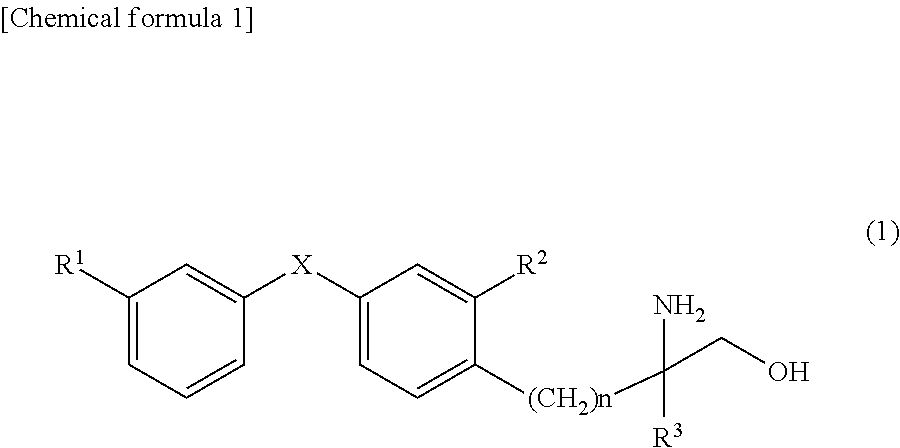Amino alcohol derivative and immunosuppresive agent having same as an active ingredient
a technology of amino alcohol and active ingredient, applied in the direction of immunological disorders, drug compositions, animal repellents, etc., can solve the problems of insufficient immunosuppressive activity of amino alcohol derivatives, insufficient effectiveness of these pharmaceuticals, and insufficient immunosuppressive effects of pharmaceuticals, etc., to achieve excellent immunosuppressive activity and safety.
- Summary
- Abstract
- Description
- Claims
- Application Information
AI Technical Summary
Benefits of technology
Problems solved by technology
Method used
Image
Examples
reference example 1
2-Fluoro-4-(3-trifluoromethylphenylthio)benzaldehyde
[0148]
[0149]Under an argon atmosphere, ethyldiisopropylamine (7.0 mL), tris(dibenzylideneacetone)dipalladium(0) chloroform adduct (518 mg), xantphos (578 mg), and 3-trifluoromethylthiophenol (3.56 g) were added at room temperature into a solution of 4-bromo-2-fluorobenzaldehyde (4.06 g) in 1,4-dioxane (42 mL), and the resultant solution was heated to reflux for 5 hours. To the reaction solution added water, extracted with ethyl acetate, washed with water and saturated brine in that order, and then dried over anhydrous sodium sulfate. The solvent was evaporated, and the resultant residue was purified by silica gel column chromatography (hexane:ethyl acetate 30:1) to obtain the target product (4.08 g) as a colorless oil.
[0150]1H-NMR (CDCl3, 400 MHz): δ 6.86 (1H, dd, J=10, 1.8 Hz), 7.02 (1H, dd, J=7.9, 1.8 Hz), 7.58 (1H, t, J=7.9 Hz), 7.68-7.73 (2H, m), 7.76 (1H, t, J=7.9 Hz), 7.80 (1H, s), 10.26 (1H, s)
[0151]EIMS (+): 300 [M]+.
reference example 2
2-Chloro-4-(3-chlorophenylthio)benzaldehyde
[0152]
[0153]3-Chlorobenzenethiol and 2-chloro-4-fluorobenzaldehyde were reacted according to the same experiment procedures as in Reference Example 1 of the pamphlet of WO 03029205 to obtain the target product as a colorless oil.
[0154]1H-NMR (CDCl3, 400 MHz): δ 7.11 (1H, dd, J=9.2, 1.8 Hz), 7.17 (1H, d, J=1.8 Hz), 7.36-7.44 (3H, m), 7.52 (1H, t, J=1.8 Hz), 7.80 (1H, d, J=7.9 Hz), 10.37 (1H, s)
[0155]EIMS (+): 282 [M]+.
reference example 3
2-Chloro-4-(3-methylphenoxy)benzaldehyde
[0156]
[0157]m-Cresol and 2-chloro-4-fluorobenzaldehyde were reacted according to the same experiment procedures as in Reference Example 1 of the pamphlet of WO 03029184 to obtain the target product as a colorless powder.
[0158]1H-NMR (CDCl3, 400 MHz): δ 2.38 (3H, s), 6.87-6.96 (4H, m), 7.07 (1H, d, J=7.3 Hz), 7.31 (1H, t, J=7.6 Hz), 7.90 (1H, d, J=8.60 Hz), 10.36 (1H, s)
[0159]EIMS (+): 246 [M]+.
PUM
| Property | Measurement | Unit |
|---|---|---|
| temperature | aaaaa | aaaaa |
| temperature | aaaaa | aaaaa |
| temperature | aaaaa | aaaaa |
Abstract
Description
Claims
Application Information
 Login to View More
Login to View More - R&D
- Intellectual Property
- Life Sciences
- Materials
- Tech Scout
- Unparalleled Data Quality
- Higher Quality Content
- 60% Fewer Hallucinations
Browse by: Latest US Patents, China's latest patents, Technical Efficacy Thesaurus, Application Domain, Technology Topic, Popular Technical Reports.
© 2025 PatSnap. All rights reserved.Legal|Privacy policy|Modern Slavery Act Transparency Statement|Sitemap|About US| Contact US: help@patsnap.com



